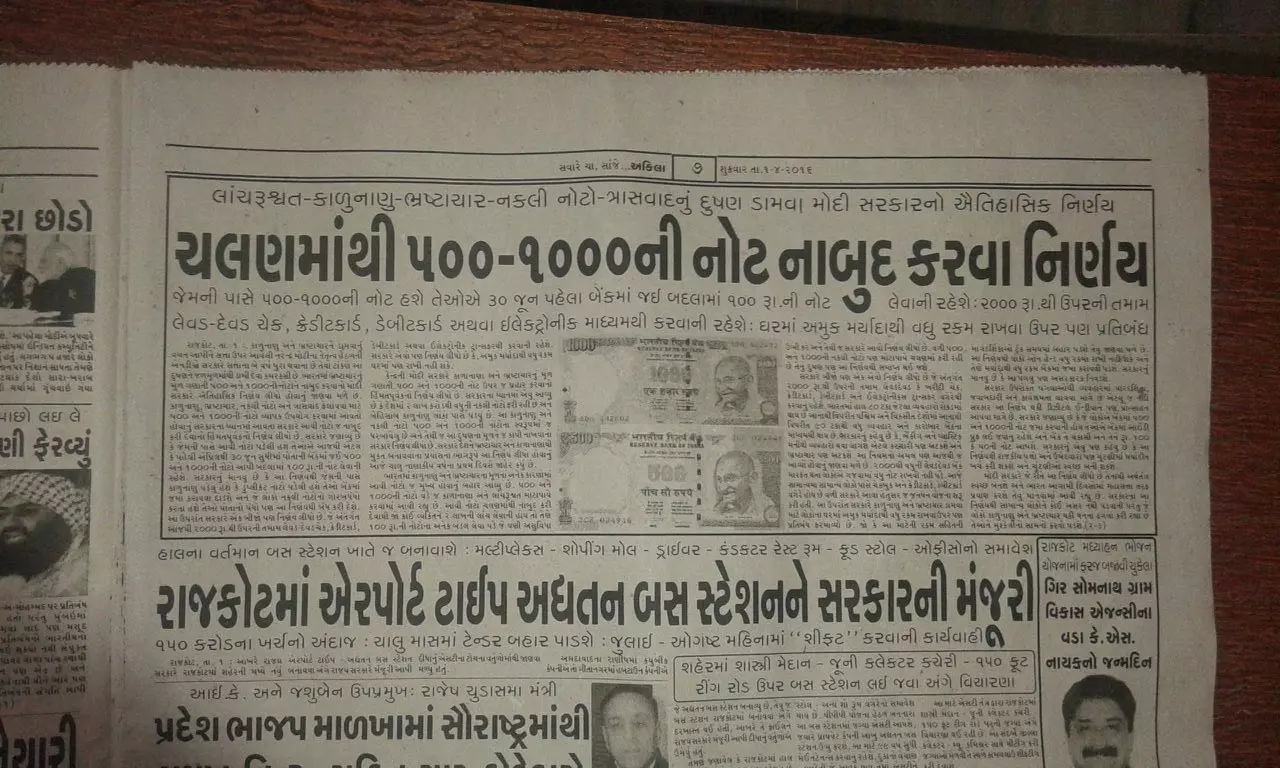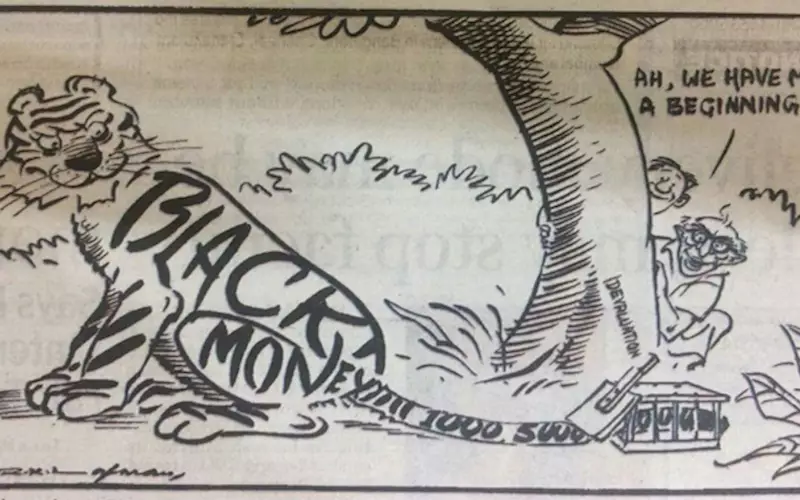To monetise or to demonetise? - The Noel D'Cunha Sunday Column
In a 40-minute long speech Prime Minister Narendra Modi stunned the nation by announcing the scrapping of Rs 500 and Rs 1,000 currency notes. The Noel D'Cunha - Sunday Column unravels the drama that unfolded, thereafter.
11 Nov 2016 | By Noel D'Cunha
Some said, it was an act of genius, some said it was an act of desperation.
The government and its supporters said it was an assault on black money, fake currency and corruption.
The opposition said, it was emergency; an economic emergency.
Union Minister Kiren Rijiju said, the demonetisation of Rs 1,000 and Rs 500 notes will lead to closure of "printing press" in Pakistan, where fake Indian currency notes are printed.
Chief Minister of Delhi, Arvind Kejriwal asked about the logic behind the introduction of Rs 2,000 notes, saying it will fan corruption and the black money economy instead of containing it and that demonetisation has hit the "aam admi" hard.
Union Minister Prakash Javadekar said, "This is real independence for the common man and uncorrupt majority."
Former Union Minister Manish Tiwari said, "Mohammed Bin Tughlak scraps 500/1,000 rupees notes. Next capital of India will be shifted from Delhi to Daultabad. Tughlak's spirit resurrects."
Meanwhile, economists on the nation's noisiest TV channel said, "The government’s decision to ban Rs 500 and Rs 1,000 notes may temporarily slow down the broader economy’s growth as consumer spending will fall in the immediate weeks as households adjust to the new system but in the long-term, it is all good. Anyone who objects to this move is anti-Indian."
And yet, the people are objecting.
The rich say, the move is anti rich.
The poor say, the move is anti poor.
The very very rich simply didn't care in their villas on the islands of Cayman and Mauritus.
The very poor farmer and labourer don't know what the fuss was all about. Most of them don't have a bank account.
Rs 500 and Rs 1,000 say the move was anti-them.
Rs 10 is quaking. Last heard it was crying out at the RBI HQ gates, 500 Bhaiyya, is it my turn next?
Mysuru makes money
The good news for we the print industry is, new notes have been designed and printed at the Bharatiya Reserve Bank Note Mudran (BRBNMPL).
In all this chaos, spare a thought for BRBNMPL, the Reserve Bank of India’s currency printing press, in Mysuru. An estimated 500 million notes of Rs 2,000 denomination and another 500 million of Rs 500 denomination has been printed at the press in Mysuru. In TOP SECRECY!
Some notes have also been printed at the RBI currency printing press in Salboni, West Bengal. The new currency has been printed on currency paper manufactured at a recently established currency paper mill inside the premises of BRBNMPL in Mysuru.
Kudos to the master printers in Mysuru and West Bengal.
Meanwhile the rumours are flying thick and fast on prime-time Hindi TV channels. The thing is: the older currency design seals were stolen from Germany and had found their way to a printing press in Karachi. That's why new designs, new notes.
Polite question: As an honest taxpayer I want to know shouldn't some babu in North Block be held accountable if this is true? After all, this is a huge cost to the nation.
Currency denotification: the big picture
Cost to the nation
Other than the inconvenience to the honest people in the nation, there is the cost of printing currency.

According to a RBI study, the cost of printing a Rs 10 note was Rs 0.96 (according to the data), or 9.6% of face value. The cost of printing a Rs 1,000 note (Rs 3.17), on the other hand, was only 0.32% of the face value.
A report in Mint newspaper said, "In 2014-15, the cost of printing the incremental notes of Rs 500 and Rs 1,000 denomination (assuming that no notes of these denominations were decommissioned) was Rs 2,770 crores (based on the printing costs revealed by RBI).
And so, in that particular year, the total stock of Rs 500 notes in circulation increased by Rs 3.59 trillion, while that of Rs 1,000 notes increased by Rs 3.076 trillion.
Mint argues, "If all this additional money (only Rs 6.666 trillion) had to be printed using Rs 100 notes, it would cost RBI about Rs 11,900 crore, which is more than a four-fold increase. This is without taking into consideration the increased costs of operating ATMs (since they would need to be refilled more often), and of handling money in general.
All in a total mess. And We the Nation who are footing the bill!
1978 replay
So.
This is a repeat of 1978, so say the wise people.
Prime Minister Morarji Desai, also from Gujarat, banned Rs 1,000, Rs 5,000 and Rs 10,000; along with auctioning of gold.
The then, Reserve Bank of India (RBI) governor IG Patel, an eminent economist, also hailed from Gujarat. Like Urjit Patel, the 24th also from Gujarat.
It has something to do with the water in Palana village in Gujarat’s Kheda district.
This is the same spot under the sun where Urjit Patel's grandfather lived. Likewise, the same place where IG Patel’s family hailed from.
My friends in Ahmedabad and Surat say the Gujarat connection does not end here.
The plot thickens.
Saurashtra-based newspaper predicted it in April
In the midst of the hubbub surrounding the secrecy of PM Modi’s plan to eliminate the currency notes of Rs 500 and Rs 1,000, is the awe about Gujarati newspaper Akila getting its right on 8 April 2016.
The news report in the newspaper said:
Whoever has Rs 500 or 1,000 notes, should go and change them before June 30. Transactions for higher than Rs 2,000 have to be done through electronic cards, debit cards and electronic means only. Cash more than a certain amount cannot be kept at home. These are some of the moves to stop the flow of black money and corruption, as decided by Narendra Modi on the conclusion of two years his government.
News of this historic decision has come to light. Use of fake currency for terrorist and anti-social activities will thus be stopped. Notes of these denominations in the possession of people should be surrendered.
By this move, black money will be cleaned and India will surge forward. The government’s move will have no impact on ordinary people and is only meant to expose the corrupt and those functioning with black money currency.

Fun on social media
Ramesh Srivats tweeted: During the next few days - Bhagwan teri ATM ko shanti de.
ClooneyOfKerala tweeted: Always knew Modi would bring about massive amounts of change.
Aditya Raj Kaul tweeted: Best news of the day: Just found my wallet is empty. No currency notes.
All India Bakchod tweeted: Never thought we'd ever get bhel inside a 500 rupee note.
Sorabh Pant tweeted: Value of Rs 100 will be more than value of Rs 500 for two days. This is inflation!
Shirish Kunder tweeted: Only one political party that has hoarded 100 rupee notes can now campaign for all the upcoming elections.
Madhu Menon tweeted: Can I pay my government department bribes by Paytm now?
And Paytm who got the PM to pose in its front page ads in most newspaper dailies on 9 November tweeted: We have got two words for you: Paytm Karo.
Mitroon: Watch this space for more; and watch your wallet, too. Please be nice to the chutta paisa. You never know, what is next.











 See All
See All